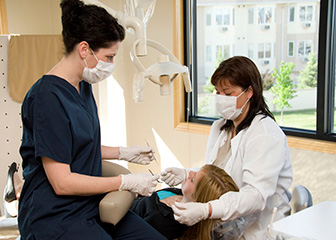Search jobs for "Dental Assistant"
| Quick Facts: Dental Assistants | |
|---|---|
| 2021 Median Pay | $38,660 per year $18.59 per hour |
| Typical Entry-Level Education | Postsecondary nondegree award |
| Work Experience in a Related Occupation | None |
| On-the-job Training | None |
| Number of Jobs, 2021 | 358,600 |
| Job Outlook, 2021-31 | 8% (faster than average) |
| Employment Change, 2021-31 | 30,100 |
Dental assistants have many tasks, including patient care, recordkeeping, and appointment scheduling. Their duties vary by state and by the dentists’ offices in which they work.

Dental assistants often spend much of their day working closely with patients and dentists. For example, dental assistants might take a patient’s medical history, blood pressure, and pulse before a procedure; explain what will be done; and talk to patients about oral care. They help dentists during a procedure by passing instruments and holding equipment such as suction hoses, matrix bands, and dental curing lights. Other tasks include preparing the treatment room and making sure that instruments and equipment are sterile. Dental assistants also may document the procedure that is done and schedule followup appointments.
Some dental assistants are specially trained to take x rays of teeth and the surrounding areas. They place a protective apron over patients’ chest and lap, position the x-ray machine, place the x-ray sensor or film in patients’ mouths, and take the x rays. Afterward, dental assistants ensure that the images are clear.
Assistants who perform lab tasks, such as taking impressions of a patient’s teeth, work under the direction of a dentist. They may prepare materials for dental impressions or temporary crowns.
Each state regulates the scope of practice for dental assistants. Some states let dental assistants polish teeth to remove stains and plaque from the enamel or apply sealants, fluoride, or topical anesthetic.
Almost all dental assistants work in dentists’ offices. Most work full time. Dental assistants work under the supervision of dentists and work closely with dental hygienists in their day-to-day activities.
Dental assistants wear safety glasses, surgical masks, protective clothing, and gloves to protect themselves and patients from infectious diseases. They also must follow safety procedures to minimize risks associated with x-ray machines.
Most dental assistants work full time. Some work evenings or weekends.
There are several possible paths to becoming a dental assistant. Some states require assistants to graduate from an accredited program and pass an exam. In other states, there are no formal educational requirements, and dental assistants learn through on-the-job training.
Some states require dental assistants to graduate from an accredited program and pass an exam. Most programs are offered by community colleges, although they also may be offered by vocational or technical schools.
Many dental assisting programs take about 1 year to complete and lead to a certificate or diploma. Programs that last 2 years are less common and lead to an associate’s degree. The Commission on Dental Accreditation (CODA), part of the American Dental Association, accredits about 250 dental assisting training programs.
Accredited programs include classroom and laboratory work. Students learn about teeth, gums, jaws, and other areas that dentists work on and the instruments that dentists use. These programs also include supervised practical experience.
High school students interested in a career as a dental assistant should take courses in anatomy, biology, and chemistry.

Detail Oriented — Dental assistants must follow specific rules and protocols, such as infection control procedures, when helping dentists treat patients.
Dexterity — Dental assistants must be good at working with their hands. They generally work in tight spaces on a small part of the body, using precise tools and instruments.
Interpersonal Skills — Dental assistants work closely with dentists. They also must be considerate in working with patients who are sensitive to pain or have a fear of undergoing dental treatment.
Listening Skills — Dental assistants must pay attention to patients and other healthcare workers. They need to follow directions from a dentist or dental hygienist so they can help treat patients and do tasks, such as taking x rays.
Organizational Skills — Dental assistants should have excellent organizational skills. They need to have the correct tools in place for a dentist or dental hygienist to use when treating a patient, and they need to maintain patient schedules and office records.
States typically do not require licenses for entry-level dental assistants. Some states require dental assistants to be licensed, registered, or certified for entry or advancement. For example, states may require assistants to meet specific licensing requirements in order to work in radiography (x ray), infection control, or other specialties. For specific requirements, contact your state’s Board of Dental Examiners.
States that allow assistants to perform expanded duties, such as coronal polishing, require that they be licensed, registered, or hold certifications from the Dental Assisting National Board (DANB). To earn certification from DANB, applicants must pass an exam. The educational requirements for DANB certification are that dental assistants must either have graduated from an accredited program or have a high school diploma and complete the required amount of work experience. Applicants also must have current certification in CPR (cardiopulmonary resuscitation).
Source: Bureau of Labor Statistics, U.S. Department of Labor, Occupational Outlook Handbook
We'll hold them here as you browse more pages.
Salary, education, and training info for various careers in healthcare
DrOfficeJobs.com
Built by happy folks in sunny Arizona!
© 2007–2025 Monsoon Joe, Inc.